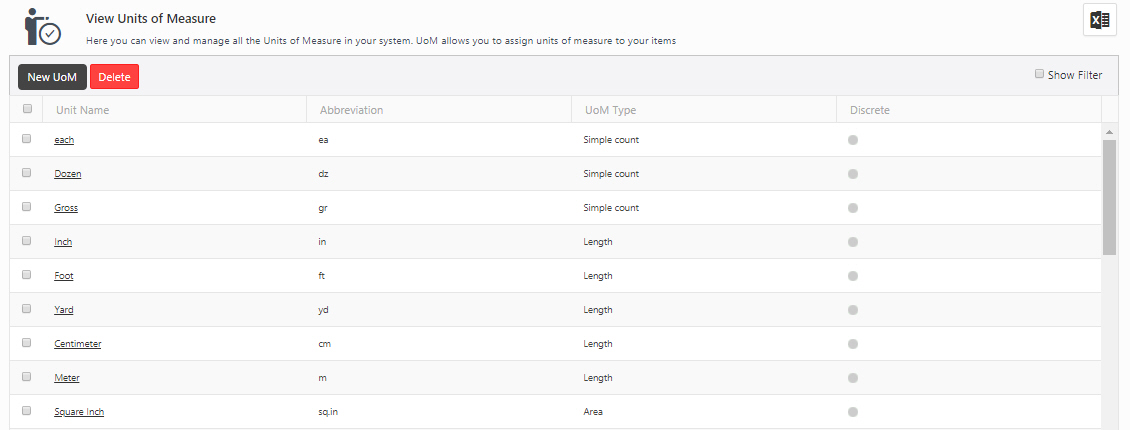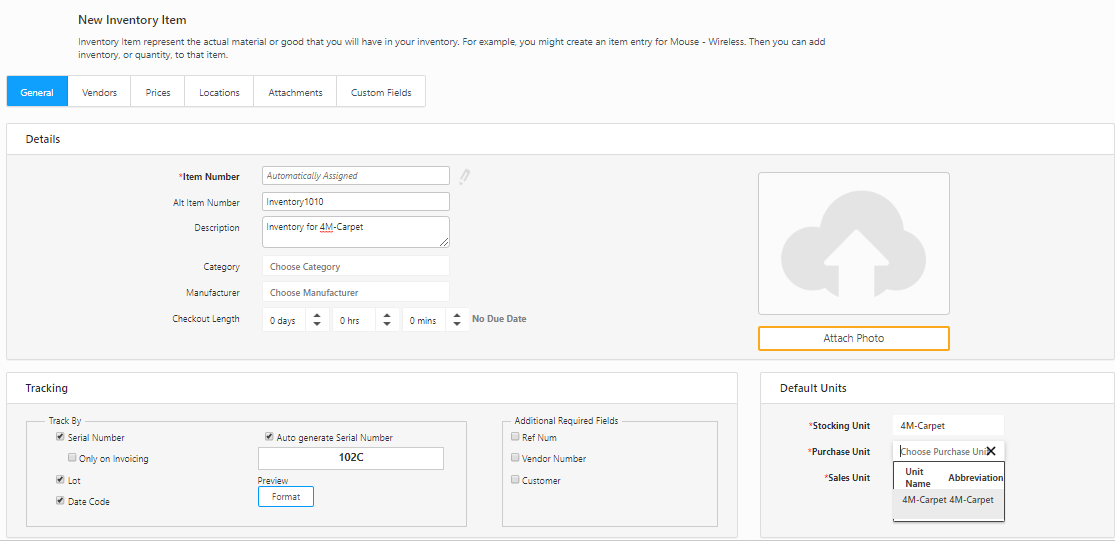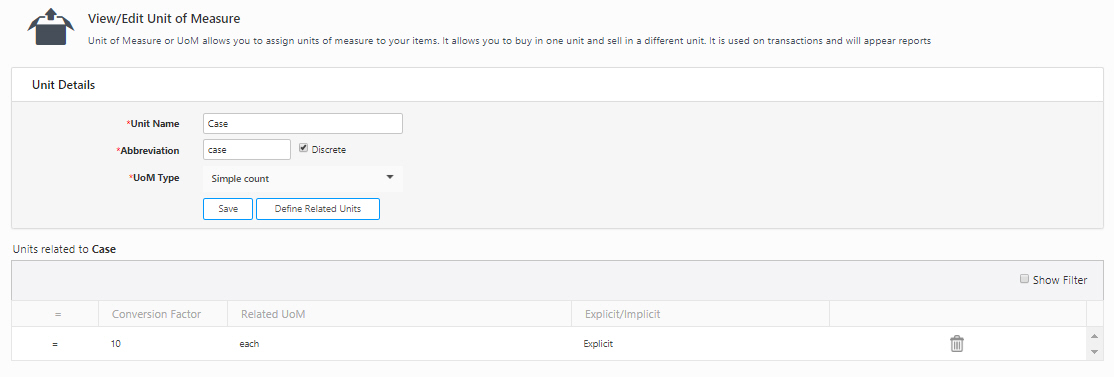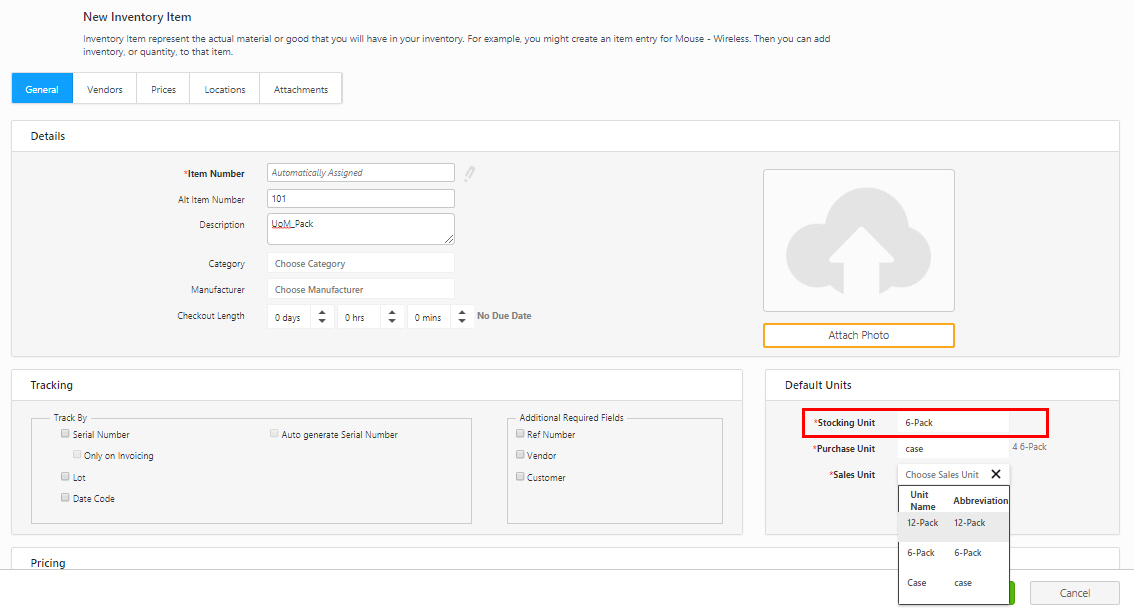Unit of Measure (UOM)
Unit of Measure or UOM allows you to assign units of measure to your items. It allows you to buy in one unit and sell in a different unit. It is used on transactions and will appear in reports.
Related Topics:
How to use Units of Measure of Different Types
View Units of Measure
- Click on the Settings -> Units of Measure.

- View Units Of Measure screen will display the unit of measure created in your system.

- Show Filter: When you click on the Show filter checkbox, a text box will appear under each field where you can type the search text to find the desired detail.

- Export (
 ) - This feature enables you to export the listed unit of measure to an Excel spreadsheet. Customize the list according to your requirements using the filters option. Once you've filtered the list to your satisfaction, click on the Export icon. This will initiate the download of the report. In most web browsers, you can access the downloaded file through an icon located at the bottom or edge of the browser window. For further guidance on locating your downloaded files, please refer to your browser's help resources. You can then save or modify the report as necessary within Excel.
) - This feature enables you to export the listed unit of measure to an Excel spreadsheet. Customize the list according to your requirements using the filters option. Once you've filtered the list to your satisfaction, click on the Export icon. This will initiate the download of the report. In most web browsers, you can access the downloaded file through an icon located at the bottom or edge of the browser window. For further guidance on locating your downloaded files, please refer to your browser's help resources. You can then save or modify the report as necessary within Excel.
Adding Unit of Measure
- Click on the Settings -> View Units of Measure -> New UOM button.

- The New Unit of Measure screen will appear.

- Enter the Unit Name.
- Enter the Abbreviation.
- Click on the Discrete checkbox. Discrete indicates that the value will be a whole number (counts). Clicking on the checkbox will round the entered value to the nearest whole value.
Note: The Discrete feature in the Units of Measure helps you to maintain Integral quantities of Stock. Refer to the topic - Discrete feature.
- Select the UOM Type. The options are Simple Count, Length, Area, Volume, Mass, and Time. Refer to the topic - Example for Simple Count.
- Click Save. A message will appear indicating that the UOM is saved successfully. A section "Unit Relationship" will appear.

- Unit Relationship - A unit relationship is required when there is a requirement to add different units in the Default Units field on the New Inventory/ New Non-Inventory/ New Kit/ New Assembly/ New Service Item screen.
Example - Adding meter in Purchase unit and Square meter in Sales Unit.
In this case, if related units are not defined, the application will not allow you to add meters and square meters as shown below. Refer to the topic - How to use Units of Measure of Different Types for more details.

- Click on the Define Related Units button.

- Enter the number and select the units that are contained in each of the new units.
- Click on the Add Relationship button. Click on the Cancel button to cancel the changes.
- A message will appear indicating that the New Unit of relationship is added.
- The newly added Unit Relationship will appear at the bottom of the screen. You can delete it by clicking on the delete icon. This section lists any relationships you have created for this unit of measure. The Explicit/Implicit column indicates whether the relationship was manually defined or calculated by Inventory Control.
- Explicit - The user added this factor manually and the relationship can be deleted.
- Implicit - The conversion factor was calculated based on the Explicit factors entered. Implicit factors cannot be deleted.

Edit Unit of Measure
Click on the Settings -> Unit of Measure. The New Unit of Measure screen will appear.
Click on the Unit of Measure link.

The screen will navigate to the View/Edit Unit of Measure screen.

Edit the desired fields. Refer to the topic - Adding a Unit Of Measure.
A message will appear, indicating that the Unit of Measure is updated successfully.
Delete a Unit of Measure
Click on the Settings -> Viewing the Unit of Measure.
Select the Unit of Measure to be deleted and click on the Delete button.

A pop-up message will appear asking for confirmation.

Click on the Delete button again. A message will appear indicating that "1 UOM is deleted successfully".
Discrete Feature
In the InventoryCloud, you can maintain Integral quantities of Stock by creating a Discrete Unit of Measure (UOM) and using that as the Stocking unit of an Item.
Example:
If you want to sell a particular beer by the 6-Pack, then you can configure the Units of Measure and the item (in the New Unit of Measure screen) to prevent users from removing individual cans of beer from the 6-Pack.

Consider the following units of measure:
- GermanCase = 25 Beers
- Case = 24 Beers
- 12-Pack = 12 Beers
- 6-Pack = 6 Beers- Discrete
- 1-Beer = 1 Each - Discrete
To prevent users from breaking 6-Packs apart, configure the 6-Pack as the stocking unit for the item and make sure that 6-Pack UOM is Discrete.

Given the above configuration, InventoryCloud can help prevent the user from breaking apart those 6-Packs of beer. To take advantage of this feature, create an Item and assign 6-Pack as the Stocking Unit of the item.

In this case, when performing transactions on this item Inventory Control will never offer the user any other UOM (like 1-Beer, Each, and GermanCase) that could create a transaction of a fractional quantity. The transactions will only be performed using the following Units of Measure:6-Pack, 12-Pack, Case.
The restriction is only applied to Items with a Discrete UOM as the stocking Unit. So, if 1-Beer is actually a bottle of German Beer just select 1-Beer as the Stocking Unit of Measure for this item so it can be bought and sold with all associated Units of Measure: Each, 1-Beer, 6-Pack, 12-Pack. Case, GermanCase.
In this case, the Discrete property can also be applied to 1-Beer just to prevent selling half a bottle.